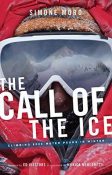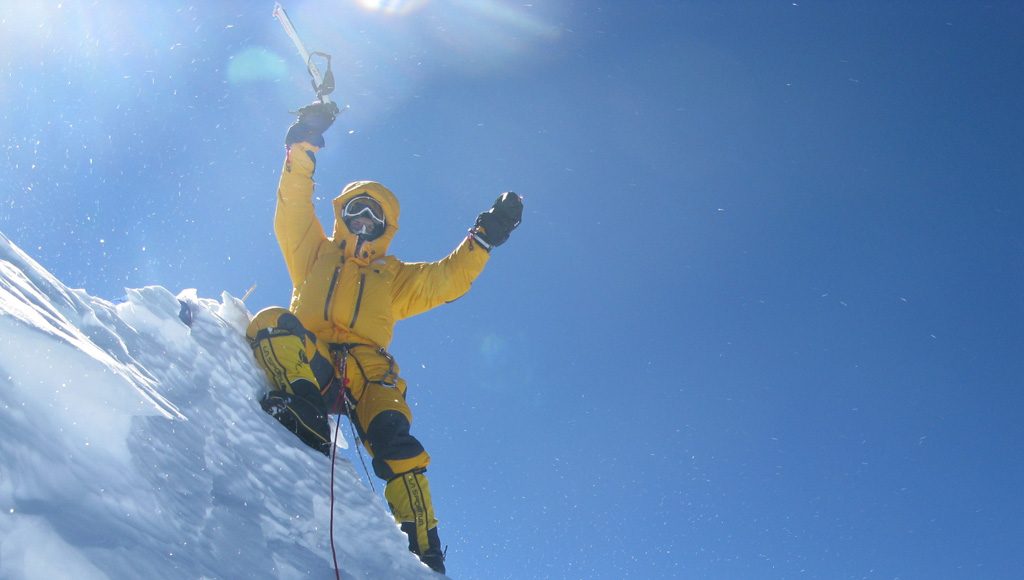It’s been a while since we interviewed Simone Moro, and we’ve been sitting on the transcript for many months now, so many other cool stuff asking our attention. And although it’s been a while, it was such a great meeting and the interview is well worth publishing (and reading 😉 ). So here it goes!
In recent years Simone Moro has been most famous for his winter ascents of the highest of the high mountains. We attended Simone’s lecture at the NKBV Bergsportdag ‘The life of an Explorer’, and were able to have a sit down with him. As much as we would have loved to hear expedition stories of Simone Moro, we had to stay true to GearLimits’ roots; which are gear. So in this interview we focussed on equipment instead of physical accomplishments.
More info about Simone’s lecture and his book(s) below (after the interview)
 Simone is a person who is not easily lost for words. He spent 20 minutes answering just two questions during the Q&A session after his presentation. And when we asked him for an example of something, he gave us three. And it’s all great stuff, it’s interesting, inspiring and entertaining, the man is full of anecdotes.
Simone is a person who is not easily lost for words. He spent 20 minutes answering just two questions during the Q&A session after his presentation. And when we asked him for an example of something, he gave us three. And it’s all great stuff, it’s interesting, inspiring and entertaining, the man is full of anecdotes.
When we asked which piece of gear saved Simone’s life, we expected he’d tell us about a belaying device or rope or ice-axe, but without hesitation Simone said ‘down’. The softest and one of the lightest materials available did that tough job. Staying warm is vital. So not the ‘hardware’ but the ‘software’ is most important, especially down mittens, jackets and suits.
And there is more ‘software’: warm boots and tents. You might think tents are only for sleeping and sweet dreams? Well think again. On expeditions, tents are also for resting and shelter. We’ve seen and heard about expeditions that had to be canceled because tents were ripped apart by storms or avalanches.
Exploring extreme, cold conditions
While exploring, says Simone, the main focus is to keep your body warm in extreme conditions; your hands, feet and your head. In his opinion there is no better insulation than down. “If you’re climbing with -40°C or -60°C… take your down Himalayan suit and mitts. Down is still the best – and natural – product that can safe your life”. Other extra insulating materials Simon uses are, polar fleece, Thermoball and woolen socks “Never put synthetic on your feet”. Combining these with down can keep you alive.
Technology and innovation hiccups
Simone is a professional alpinist, climber, base jumper, helicopter pilot and speaker.
He is also a gear innovator and works with a company designing a new way of heating insoles. The hard part of this development is to incorporate the battery of only a few millimetres thickness. The durability of that battery should be several days. “We are testing a prototype right now, but it not ready yet. It’s working at home and it is working at the base-camp. However it is malfunctioning on the mountain. But it will be there…”
Low quality gear causes failure
Two pieces of equipment that can lead to frostbite are boots and gloves of poor quality. If a jacket isn’t ventilating well, you will sweat a lot, but that’s not life threatening. If your jacket is too cold, you put on an extrajacket and it will keep you warm. For hands and feet it’s important that they work properly. Simon swears by the Himalayan suit and down mitts. The Himalayan suit saved his life several times. Added to that list are sunglasses and goggles, essential in protecting your eyes. They should always of high quality.
You can’t buy performance
A millionaire can buy the best gear in the world, but “It’s not the gear that makes you a champion”. Reliable gear will help you make the difference. “But if you’re not performing well, it’s because of you. You can’t blame the gear. Actually, there is no bad gear anymore and you can buy it everywhere. The gear I’m using is available in shops.”
Crampon DIY
The day after Simon reached the summit of the Nanga Parbat, at 7200 meters, just as he started descending that morning, the binding on the back of one of the crampons broke completely. This could have been disastrous at that altitude.
Simon blamed himself for this snafu, because he decided to use a pair of crampons that were about four years old. Since he always climbs in low temperatures and strong UV light, the plastic had degraded. At that time it was not possible to repair it properly, so Simone used a piece of dynamic rope to fix it on the boot. Not too tight, otherwise it would have blocked the blood flow to his toes. He climbed down nearly 3000 meters that day.
“In such a situation there is no other option then fixing it. I always bring my key tools with me, like a thin rope, duct tape, knife, headlamp, a lighter…. and a lot of fantasy and skills.”
Gear Simone can’t do without
For the level of climbing that Simon does at the moment there are two items he will not climb without: La Sportiva boots and The North Face Himalayan suit. “If I was not sponsored by them I would buy the La Sportiva boots and The North Face Himalayan suit myself. ” Simon is also very clear about the expedition tents he’s using: “Always TNF tents. Other brands are copying them now, but they are not having that kind of quality yet.”
For GPS there is one brand, Garmin. That saved his life – like the Himalayan suit – several times. He marks the position of the basecamp before he climbed the summit. While descending they had a complete whiteout. The Garmin Fenix 3 backtracked him exactly to basecamp and gave an alert at the position of a previously marked crevasse.
Gear wishlist
For Simone it wouldn’t be necessary to invent anything to make climbing easier, but to make climbing safer, that would be welcome. In climbing, there is no such thing yet as drill that will fix a piton into the rock in just one second; (as seen in the movie “Cliffhanger”).
“We are still using battery drills from brands like Hilti, Makita, DeWalt and Bosch. We need a tool like these, but than much lighter with the size of toy drill. So it would be nice if those brands can build one that can be held easily by one hand and has enough power.”
Concerning boots Simon is looking forward to the first high altitude boots under one kilo with a very long lasting heating system .
‘The Life of an Explorer’ and ‘The Call of the Ice’
At the NKBV Bergsportdag, Simone gave a presentation about “The Life of an Explorer”. He asks himself and the audience, in this day and age, of Google Earth and almost everything being mapped, how you can still be an explorer. And also, if there even remains a need for explorers, now that you can see every corner of the world from behind your computer or smart phone. Simone says you miss out on the scent and sound as well as the silence of the real places when you visit them from your screen.
Then he speaks about who inspired him from an early age on. Starting with his father, not a mountaineer, but a top road-cyclist who was also a banker by profession and a dedicated father. Then he set out on a long list of historical figures he learned about in school who inspired him; from Dante, Da Vinci, Cristoforo Colombo, up to the pioneers of mountaineering ending with Reinhold Messner.
Simone Moro is a captivating storyteller. He wants to inspire people, for life, not necessarily for mountaineering. We shouldn’t just daydream about our proverbial ‘Everest’, but take that cloud down and not believe in the word ‘impossible’.
And if our dream would be of mountains, being born in Holland shouldn’t be an excuse for not to trying or failing. Simone himself wasn’t raised at the foot of Monte Bianco or in the middle of the Dolomites. He was born in relatively flat Bergamo. Also, lack of money or talent shouldn’t be an excuse either. If you fail you’re either not motivated, hungry, strong or tough enough.
 He wanted to inspire people, and that is certainly what he did with this presentation!
He wanted to inspire people, and that is certainly what he did with this presentation!
About his book, we haven’t read it yet, but we’re confident it’s a good read. The Call of Ice is available here.

